Abstract
Cytotoxic T lymphocytes (CTL) are important to the control of viral replication and their presence may be important to disease outcome. An understanding of the spectrum of proteins recognized by hepatitis C virus (HCV)-specific CTL and the functional properties of these cells is an important step in understanding the disease process and the mechanisms of persistent infection, which occurs in the majority of HCV-infected individuals. In this report we identify HCV-specific CTL responses restricted by the HLA class I molecules A2, A3, A11, A23, B7, B8, and B53. The epitopes recognized by these intrahepatic CTL conform to published motifs for binding to HLA class I molecules, although in some cases we have identified CTL epitopes for which no published motif exists. The use of vectors expressing two different strains of HCV, HCV-1 and HCV-H, revealed both strain-specific and cross-reactive CTL. These HCV-specific CTL were shown to produce cytokines including IFN-gamma, TNF-alpha, GM-CSF, IL-8, and IL-10 in an antigen- and HLA class I-specific manner. These studies indicate that the CTL response to HCV is broadly directed and that as many as five different epitopes may be targeted in a single individual. The identification of minimal epitopes may facilitate peptide-specific immunization strategies. In addition, the release of proinflammatory cytokines by these cells may contribute to the pathogenesis of HCV-induced liver damage.
Full text
PDF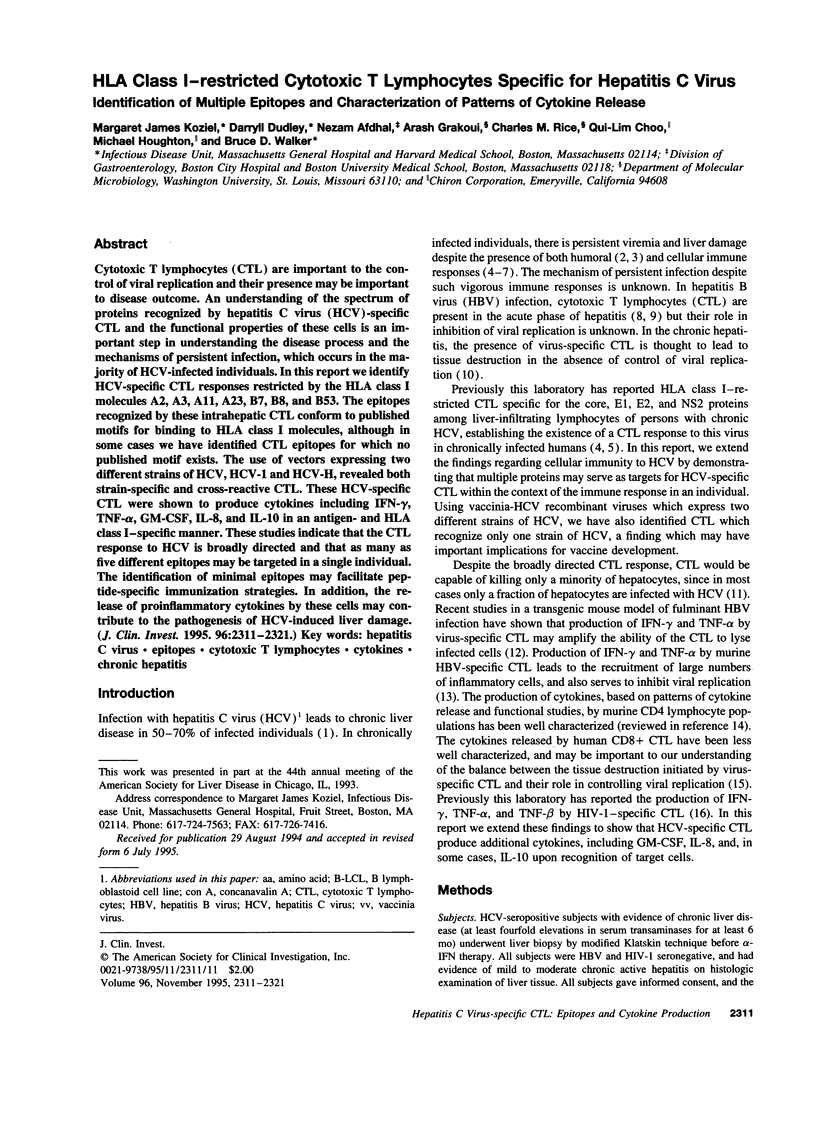
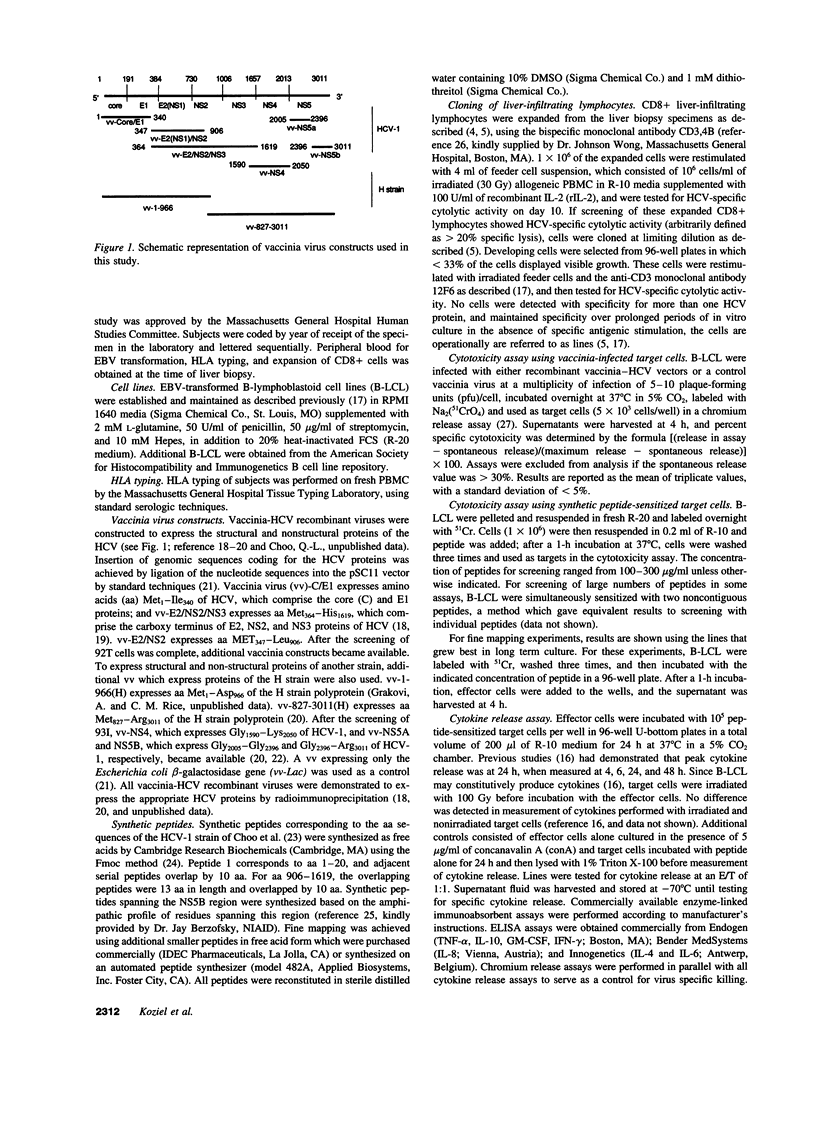
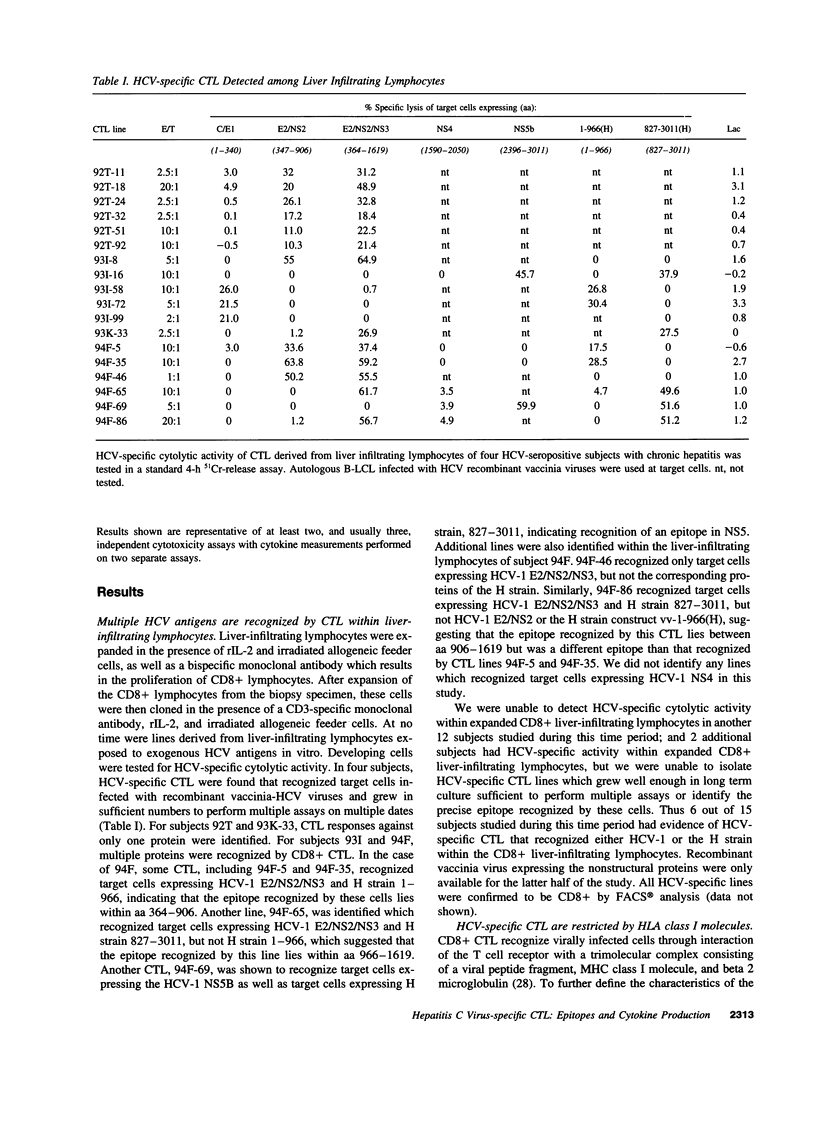
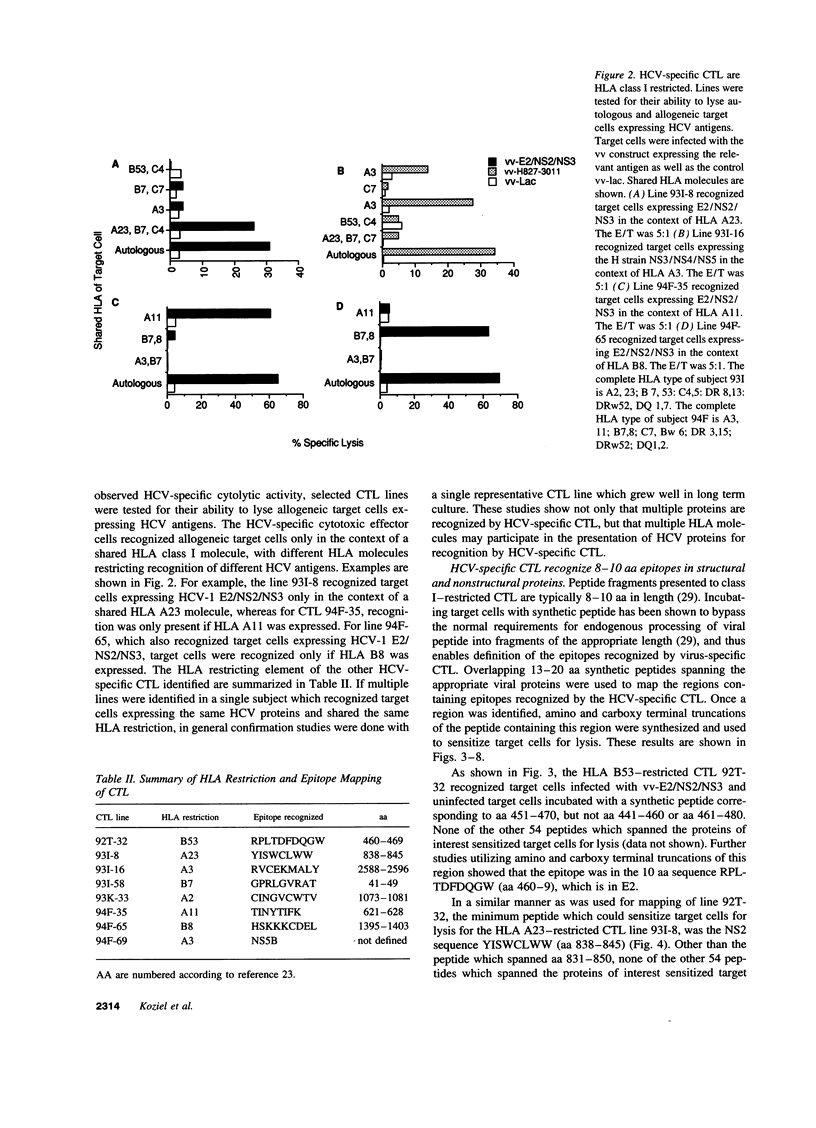
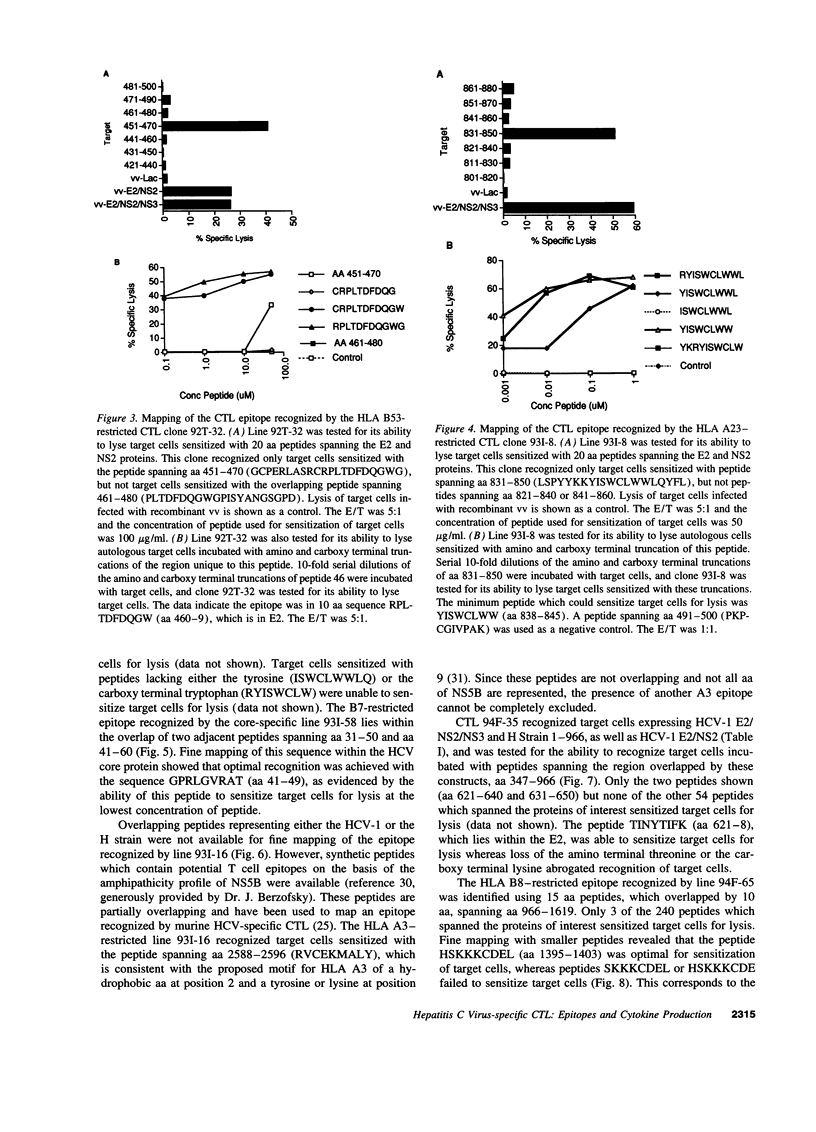
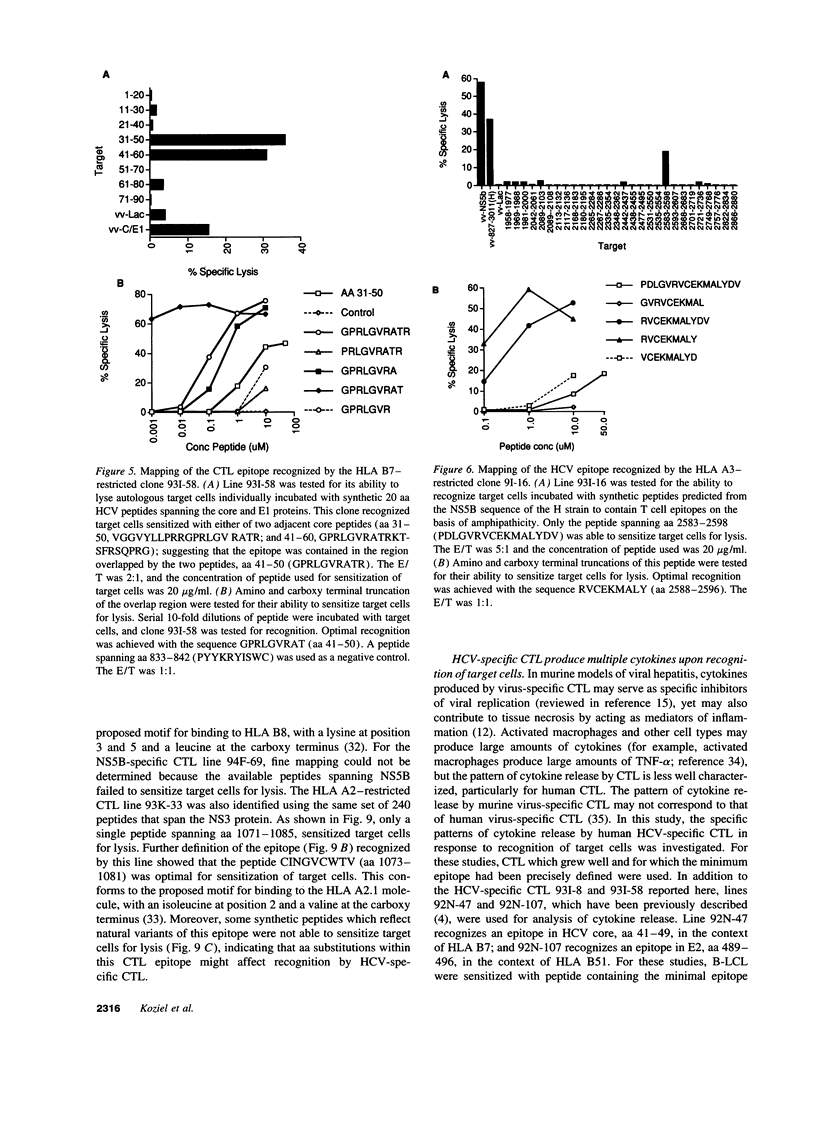
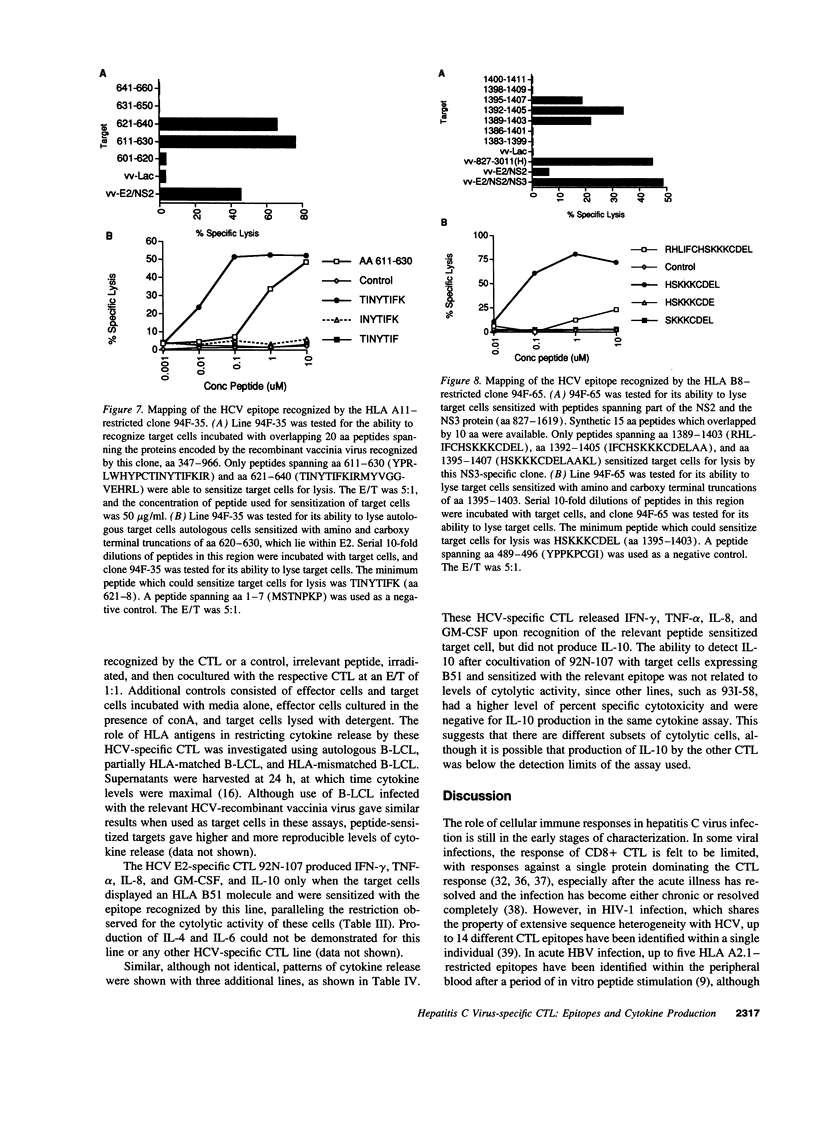
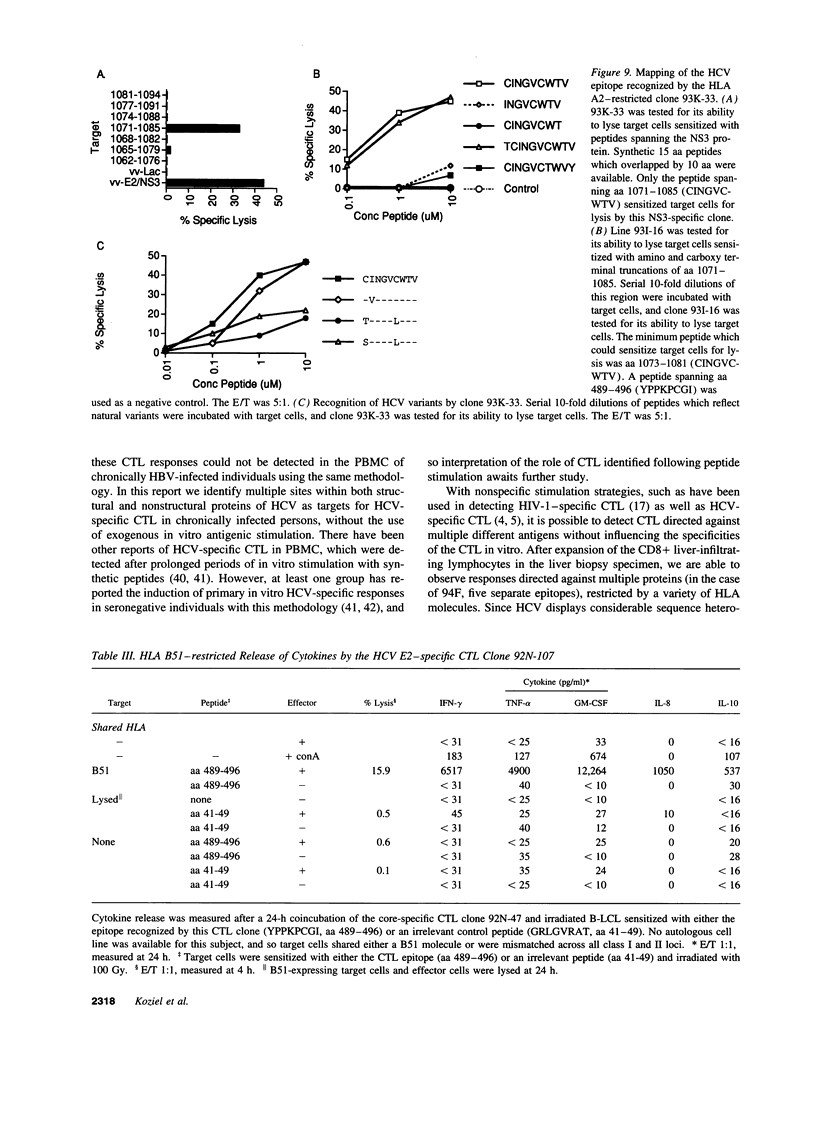
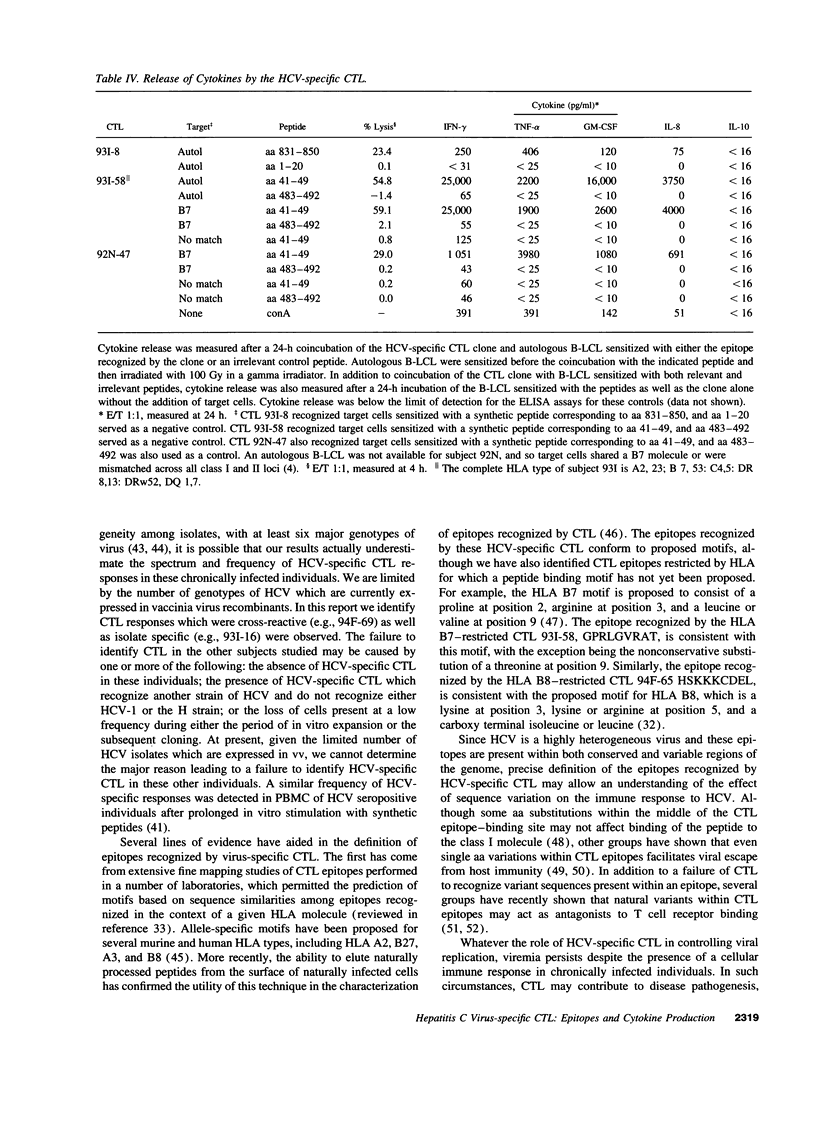
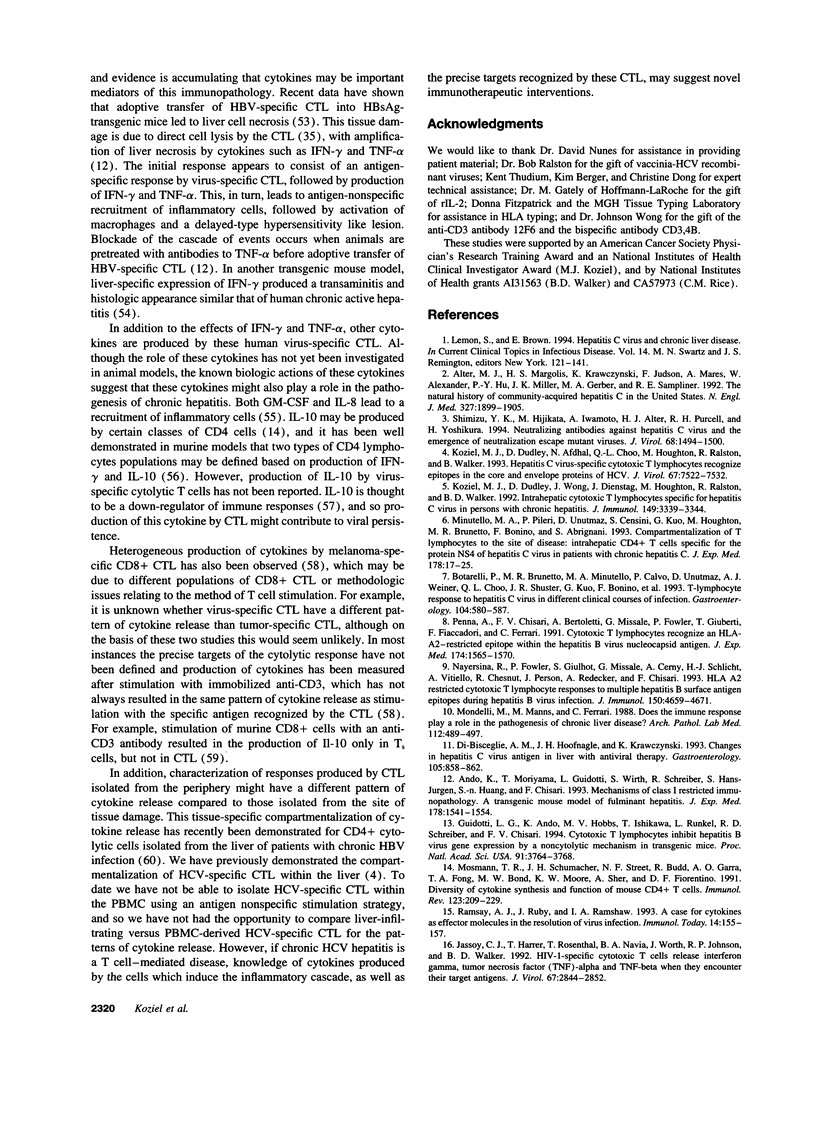
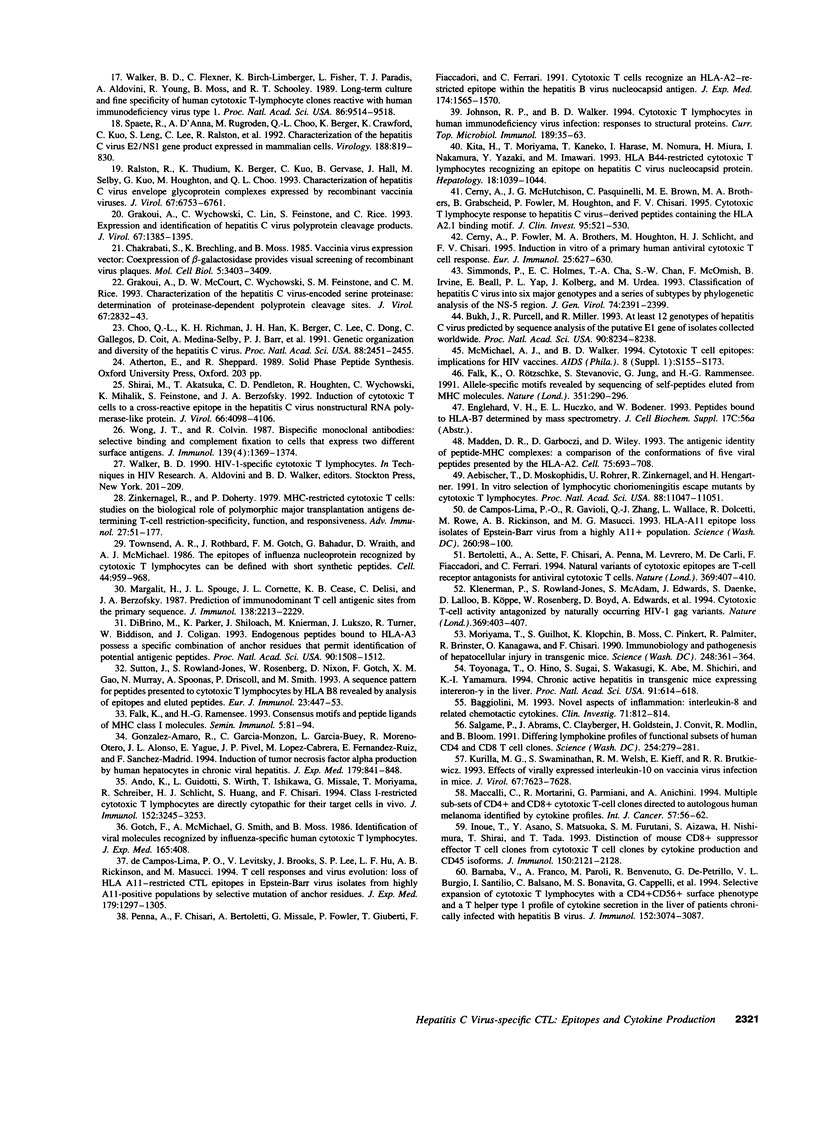
Selected References
These references are in PubMed. This may not be the complete list of references from this article.
- Aebischer T., Moskophidis D., Rohrer U. H., Zinkernagel R. M., Hengartner H. In vitro selection of lymphocytic choriomeningitis virus escape mutants by cytotoxic T lymphocytes. Proc Natl Acad Sci U S A. 1991 Dec 15;88(24):11047–11051. doi: 10.1073/pnas.88.24.11047. [DOI] [PMC free article] [PubMed] [Google Scholar]
- Alter M. J., Margolis H. S., Krawczynski K., Judson F. N., Mares A., Alexander W. J., Hu P. Y., Miller J. K., Gerber M. A., Sampliner R. E. The natural history of community-acquired hepatitis C in the United States. The Sentinel Counties Chronic non-A, non-B Hepatitis Study Team. N Engl J Med. 1992 Dec 31;327(27):1899–1905. doi: 10.1056/NEJM199212313272702. [DOI] [PubMed] [Google Scholar]
- Ando K., Guidotti L. G., Wirth S., Ishikawa T., Missale G., Moriyama T., Schreiber R. D., Schlicht H. J., Huang S. N., Chisari F. V. Class I-restricted cytotoxic T lymphocytes are directly cytopathic for their target cells in vivo. J Immunol. 1994 Apr 1;152(7):3245–3253. [PubMed] [Google Scholar]
- Ando K., Moriyama T., Guidotti L. G., Wirth S., Schreiber R. D., Schlicht H. J., Huang S. N., Chisari F. V. Mechanisms of class I restricted immunopathology. A transgenic mouse model of fulminant hepatitis. J Exp Med. 1993 Nov 1;178(5):1541–1554. doi: 10.1084/jem.178.5.1541. [DOI] [PMC free article] [PubMed] [Google Scholar]
- Baggiolini M. Novel aspects of inflammation: interleukin-8 and related chemotactic cytokines. Clin Investig. 1993 Oct;71(10):812–814. doi: 10.1007/BF00190326. [DOI] [PubMed] [Google Scholar]
- Barnaba V., Franco A., Paroli M., Benvenuto R., De Petrillo G., Burgio V. L., Santilio I., Balsano C., Bonavita M. S., Cappelli G. Selective expansion of cytotoxic T lymphocytes with a CD4+CD56+ surface phenotype and a T helper type 1 profile of cytokine secretion in the liver of patients chronically infected with Hepatitis B virus. J Immunol. 1994 Mar 15;152(6):3074–3087. [PubMed] [Google Scholar]
- Bertoletti A., Sette A., Chisari F. V., Penna A., Levrero M., De Carli M., Fiaccadori F., Ferrari C. Natural variants of cytotoxic epitopes are T-cell receptor antagonists for antiviral cytotoxic T cells. Nature. 1994 Jun 2;369(6479):407–410. doi: 10.1038/369407a0. [DOI] [PubMed] [Google Scholar]
- Botarelli P., Brunetto M. R., Minutello M. A., Calvo P., Unutmaz D., Weiner A. J., Choo Q. L., Shuster J. R., Kuo G., Bonino F. T-lymphocyte response to hepatitis C virus in different clinical courses of infection. Gastroenterology. 1993 Feb;104(2):580–587. doi: 10.1016/0016-5085(93)90430-k. [DOI] [PubMed] [Google Scholar]
- Bukh J., Purcell R. H., Miller R. H. At least 12 genotypes of hepatitis C virus predicted by sequence analysis of the putative E1 gene of isolates collected worldwide. Proc Natl Acad Sci U S A. 1993 Sep 1;90(17):8234–8238. doi: 10.1073/pnas.90.17.8234. [DOI] [PMC free article] [PubMed] [Google Scholar]
- Cerny A., Fowler P., Brothers M. A., Houghton M., Schlicht H. J., Chisari F. V. Induction in vitro of a primary human antiviral cytotoxic T cell response. Eur J Immunol. 1995 Feb;25(2):627–630. doi: 10.1002/eji.1830250248. [DOI] [PubMed] [Google Scholar]
- Cerny A., McHutchison J. G., Pasquinelli C., Brown M. E., Brothers M. A., Grabscheid B., Fowler P., Houghton M., Chisari F. V. Cytotoxic T lymphocyte response to hepatitis C virus-derived peptides containing the HLA A2.1 binding motif. J Clin Invest. 1995 Feb;95(2):521–530. doi: 10.1172/JCI117694. [DOI] [PMC free article] [PubMed] [Google Scholar]
- Chakrabarti S., Brechling K., Moss B. Vaccinia virus expression vector: coexpression of beta-galactosidase provides visual screening of recombinant virus plaques. Mol Cell Biol. 1985 Dec;5(12):3403–3409. doi: 10.1128/mcb.5.12.3403. [DOI] [PMC free article] [PubMed] [Google Scholar]
- Choo Q. L., Richman K. H., Han J. H., Berger K., Lee C., Dong C., Gallegos C., Coit D., Medina-Selby R., Barr P. J. Genetic organization and diversity of the hepatitis C virus. Proc Natl Acad Sci U S A. 1991 Mar 15;88(6):2451–2455. doi: 10.1073/pnas.88.6.2451. [DOI] [PMC free article] [PubMed] [Google Scholar]
- Di Bisceglie A. M., Hoofnagle J. H., Krawczynski K. Changes in hepatitis C virus antigen in liver with antiviral therapy. Gastroenterology. 1993 Sep;105(3):858–862. doi: 10.1016/0016-5085(93)90905-r. [DOI] [PubMed] [Google Scholar]
- DiBrino M., Parker K. C., Shiloach J., Knierman M., Lukszo J., Turner R. V., Biddison W. E., Coligan J. E. Endogenous peptides bound to HLA-A3 possess a specific combination of anchor residues that permit identification of potential antigenic peptides. Proc Natl Acad Sci U S A. 1993 Feb 15;90(4):1508–1512. doi: 10.1073/pnas.90.4.1508. [DOI] [PMC free article] [PubMed] [Google Scholar]
- Falk K., Rötzschke O. Consensus motifs and peptide ligands of MHC class I molecules. Semin Immunol. 1993 Apr;5(2):81–94. doi: 10.1006/smim.1993.1012. [DOI] [PubMed] [Google Scholar]
- Falk K., Rötzschke O., Stevanović S., Jung G., Rammensee H. G. Allele-specific motifs revealed by sequencing of self-peptides eluted from MHC molecules. Nature. 1991 May 23;351(6324):290–296. doi: 10.1038/351290a0. [DOI] [PubMed] [Google Scholar]
- González-Amaro R., García-Monzón C., García-Buey L., Moreno-Otero R., Alonso J. L., Yagüe E., Pivel J. P., López-Cabrera M., Fernández-Ruiz E., Sánchez-Madrid F. Induction of tumor necrosis factor alpha production by human hepatocytes in chronic viral hepatitis. J Exp Med. 1994 Mar 1;179(3):841–848. doi: 10.1084/jem.179.3.841. [DOI] [PMC free article] [PubMed] [Google Scholar]
- Gotch F., McMichael A., Smith G., Moss B. Identification of viral molecules recognized by influenza-specific human cytotoxic T lymphocytes. J Exp Med. 1987 Feb 1;165(2):408–416. doi: 10.1084/jem.165.2.408. [DOI] [PMC free article] [PubMed] [Google Scholar]
- Grakoui A., McCourt D. W., Wychowski C., Feinstone S. M., Rice C. M. Characterization of the hepatitis C virus-encoded serine proteinase: determination of proteinase-dependent polyprotein cleavage sites. J Virol. 1993 May;67(5):2832–2843. doi: 10.1128/jvi.67.5.2832-2843.1993. [DOI] [PMC free article] [PubMed] [Google Scholar]
- Grakoui A., Wychowski C., Lin C., Feinstone S. M., Rice C. M. Expression and identification of hepatitis C virus polyprotein cleavage products. J Virol. 1993 Mar;67(3):1385–1395. doi: 10.1128/jvi.67.3.1385-1395.1993. [DOI] [PMC free article] [PubMed] [Google Scholar]
- Guidotti L. G., Ando K., Hobbs M. V., Ishikawa T., Runkel L., Schreiber R. D., Chisari F. V. Cytotoxic T lymphocytes inhibit hepatitis B virus gene expression by a noncytolytic mechanism in transgenic mice. Proc Natl Acad Sci U S A. 1994 Apr 26;91(9):3764–3768. doi: 10.1073/pnas.91.9.3764. [DOI] [PMC free article] [PubMed] [Google Scholar]
- Inoue T., Asano Y., Matsuoka S., Furutani-Seiki M., Aizawa S., Nishimura H., Shirai T., Tada T. Distinction of mouse CD8+ suppressor effector T cell clones from cytotoxic T cell clones by cytokine production and CD45 isoforms. J Immunol. 1993 Mar 15;150(6):2121–2128. [PubMed] [Google Scholar]
- Jassoy C., Harrer T., Rosenthal T., Navia B. A., Worth J., Johnson R. P., Walker B. D. Human immunodeficiency virus type 1-specific cytotoxic T lymphocytes release gamma interferon, tumor necrosis factor alpha (TNF-alpha), and TNF-beta when they encounter their target antigens. J Virol. 1993 May;67(5):2844–2852. doi: 10.1128/jvi.67.5.2844-2852.1993. [DOI] [PMC free article] [PubMed] [Google Scholar]
- Johnson R. P., Walker B. D. Cytotoxic T lymphocytes in human immunodeficiency virus infection: responses to structural proteins. Curr Top Microbiol Immunol. 1994;189:35–63. doi: 10.1007/978-3-642-78530-6_3. [DOI] [PubMed] [Google Scholar]
- Kita H., Moriyama T., Kaneko T., Harase I., Nomura M., Miura H., Nakamura I., Yazaki Y., Imawari M. HLA B44-restricted cytotoxic T lymphocytes recognizing an epitope on hepatitis C virus nucleocapsid protein. Hepatology. 1993 Nov;18(5):1039–1044. [PubMed] [Google Scholar]
- Klenerman P., Rowland-Jones S., McAdam S., Edwards J., Daenke S., Lalloo D., Köppe B., Rosenberg W., Boyd D., Edwards A. Cytotoxic T-cell activity antagonized by naturally occurring HIV-1 Gag variants. Nature. 1994 Jun 2;369(6479):403–407. doi: 10.1038/369403a0. [DOI] [PubMed] [Google Scholar]
- Koziel M. J., Dudley D., Afdhal N., Choo Q. L., Houghton M., Ralston R., Walker B. D. Hepatitis C virus (HCV)-specific cytotoxic T lymphocytes recognize epitopes in the core and envelope proteins of HCV. J Virol. 1993 Dec;67(12):7522–7532. doi: 10.1128/jvi.67.12.7522-7532.1993. [DOI] [PMC free article] [PubMed] [Google Scholar]
- Koziel M. J., Dudley D., Wong J. T., Dienstag J., Houghton M., Ralston R., Walker B. D. Intrahepatic cytotoxic T lymphocytes specific for hepatitis C virus in persons with chronic hepatitis. J Immunol. 1992 Nov 15;149(10):3339–3344. [PubMed] [Google Scholar]
- Kurilla M. G., Swaminathan S., Welsh R. M., Kieff E., Brutkiewicz R. R. Effects of virally expressed interleukin-10 on vaccinia virus infection in mice. J Virol. 1993 Dec;67(12):7623–7628. doi: 10.1128/jvi.67.12.7623-7628.1993. [DOI] [PMC free article] [PubMed] [Google Scholar]
- Lemon S. M., Brown E. A. Hepatitis C virus and chronic liver disease. Curr Clin Top Infect Dis. 1994;14:120–141. [PubMed] [Google Scholar]
- Maccalli C., Mortarini R., Parmiani G., Anichini A. Multiple sub-sets of CD4+ and CD8+ cytotoxic T-cell clones directed to autologous human melanoma identified by cytokine profiles. Int J Cancer. 1994 Apr 1;57(1):56–62. doi: 10.1002/ijc.2910570111. [DOI] [PubMed] [Google Scholar]
- Madden D. R., Garboczi D. N., Wiley D. C. The antigenic identity of peptide-MHC complexes: a comparison of the conformations of five viral peptides presented by HLA-A2. Cell. 1993 Nov 19;75(4):693–708. doi: 10.1016/0092-8674(93)90490-h. [DOI] [PubMed] [Google Scholar]
- Margalit H., Spouge J. L., Cornette J. L., Cease K. B., Delisi C., Berzofsky J. A. Prediction of immunodominant helper T cell antigenic sites from the primary sequence. J Immunol. 1987 Apr 1;138(7):2213–2229. [PubMed] [Google Scholar]
- Minutello M. A., Pileri P., Unutmaz D., Censini S., Kuo G., Houghton M., Brunetto M. R., Bonino F., Abrignani S. Compartmentalization of T lymphocytes to the site of disease: intrahepatic CD4+ T cells specific for the protein NS4 of hepatitis C virus in patients with chronic hepatitis C. J Exp Med. 1993 Jul 1;178(1):17–25. doi: 10.1084/jem.178.1.17. [DOI] [PMC free article] [PubMed] [Google Scholar]
- Mondelli M. U., Manns M., Ferrari C. Does the immune response play a role in the pathogenesis of chronic liver disease? Arch Pathol Lab Med. 1988 May;112(5):489–497. [PubMed] [Google Scholar]
- Moriyama T., Guilhot S., Klopchin K., Moss B., Pinkert C. A., Palmiter R. D., Brinster R. L., Kanagawa O., Chisari F. V. Immunobiology and pathogenesis of hepatocellular injury in hepatitis B virus transgenic mice. Science. 1990 Apr 20;248(4953):361–364. doi: 10.1126/science.1691527. [DOI] [PubMed] [Google Scholar]
- Mosmann T. R., Schumacher J. H., Street N. F., Budd R., O'Garra A., Fong T. A., Bond M. W., Moore K. W., Sher A., Fiorentino D. F. Diversity of cytokine synthesis and function of mouse CD4+ T cells. Immunol Rev. 1991 Oct;123:209–229. doi: 10.1111/j.1600-065x.1991.tb00612.x. [DOI] [PubMed] [Google Scholar]
- Nayersina R., Fowler P., Guilhot S., Missale G., Cerny A., Schlicht H. J., Vitiello A., Chesnut R., Person J. L., Redeker A. G. HLA A2 restricted cytotoxic T lymphocyte responses to multiple hepatitis B surface antigen epitopes during hepatitis B virus infection. J Immunol. 1993 May 15;150(10):4659–4671. [PubMed] [Google Scholar]
- Penna A., Chisari F. V., Bertoletti A., Missale G., Fowler P., Giuberti T., Fiaccadori F., Ferrari C. Cytotoxic T lymphocytes recognize an HLA-A2-restricted epitope within the hepatitis B virus nucleocapsid antigen. J Exp Med. 1991 Dec 1;174(6):1565–1570. doi: 10.1084/jem.174.6.1565. [DOI] [PMC free article] [PubMed] [Google Scholar]
- Penna A., Chisari F. V., Bertoletti A., Missale G., Fowler P., Giuberti T., Fiaccadori F., Ferrari C. Cytotoxic T lymphocytes recognize an HLA-A2-restricted epitope within the hepatitis B virus nucleocapsid antigen. J Exp Med. 1991 Dec 1;174(6):1565–1570. doi: 10.1084/jem.174.6.1565. [DOI] [PMC free article] [PubMed] [Google Scholar]
- Ralston R., Thudium K., Berger K., Kuo C., Gervase B., Hall J., Selby M., Kuo G., Houghton M., Choo Q. L. Characterization of hepatitis C virus envelope glycoprotein complexes expressed by recombinant vaccinia viruses. J Virol. 1993 Nov;67(11):6753–6761. doi: 10.1128/jvi.67.11.6753-6761.1993. [DOI] [PMC free article] [PubMed] [Google Scholar]
- Ramsay A. J., Ruby J., Ramshaw I. A. A case for cytokines as effector molecules in the resolution of virus infection. Immunol Today. 1993 Apr;14(4):155–157. doi: 10.1016/0167-5699(93)90277-R. [DOI] [PubMed] [Google Scholar]
- Salgame P., Abrams J. S., Clayberger C., Goldstein H., Convit J., Modlin R. L., Bloom B. R. Differing lymphokine profiles of functional subsets of human CD4 and CD8 T cell clones. Science. 1991 Oct 11;254(5029):279–282. doi: 10.1126/science.254.5029.279. [DOI] [PubMed] [Google Scholar]
- Shimizu Y. K., Hijikata M., Iwamoto A., Alter H. J., Purcell R. H., Yoshikura H. Neutralizing antibodies against hepatitis C virus and the emergence of neutralization escape mutant viruses. J Virol. 1994 Mar;68(3):1494–1500. doi: 10.1128/jvi.68.3.1494-1500.1994. [DOI] [PMC free article] [PubMed] [Google Scholar]
- Shirai M., Akatsuka T., Pendleton C. D., Houghten R., Wychowski C., Mihalik K., Feinstone S., Berzofsky J. A. Induction of cytotoxic T cells to a cross-reactive epitope in the hepatitis C virus nonstructural RNA polymerase-like protein. J Virol. 1992 Jul;66(7):4098–4106. doi: 10.1128/jvi.66.7.4098-4106.1992. [DOI] [PMC free article] [PubMed] [Google Scholar]
- Simmonds P., Holmes E. C., Cha T. A., Chan S. W., McOmish F., Irvine B., Beall E., Yap P. L., Kolberg J., Urdea M. S. Classification of hepatitis C virus into six major genotypes and a series of subtypes by phylogenetic analysis of the NS-5 region. J Gen Virol. 1993 Nov;74(Pt 11):2391–2399. doi: 10.1099/0022-1317-74-11-2391. [DOI] [PubMed] [Google Scholar]
- Spaete R. R., Alexander D., Rugroden M. E., Choo Q. L., Berger K., Crawford K., Kuo C., Leng S., Lee C., Ralston R. Characterization of the hepatitis C virus E2/NS1 gene product expressed in mammalian cells. Virology. 1992 Jun;188(2):819–830. doi: 10.1016/0042-6822(92)90537-y. [DOI] [PubMed] [Google Scholar]
- Sutton J., Rowland-Jones S., Rosenberg W., Nixon D., Gotch F., Gao X. M., Murray N., Spoonas A., Driscoll P., Smith M. A sequence pattern for peptides presented to cytotoxic T lymphocytes by HLA B8 revealed by analysis of epitopes and eluted peptides. Eur J Immunol. 1993 Feb;23(2):447–453. doi: 10.1002/eji.1830230222. [DOI] [PubMed] [Google Scholar]
- Townsend A. R., Rothbard J., Gotch F. M., Bahadur G., Wraith D., McMichael A. J. The epitopes of influenza nucleoprotein recognized by cytotoxic T lymphocytes can be defined with short synthetic peptides. Cell. 1986 Mar 28;44(6):959–968. doi: 10.1016/0092-8674(86)90019-x. [DOI] [PubMed] [Google Scholar]
- Toyonaga T., Hino O., Sugai S., Wakasugi S., Abe K., Shichiri M., Yamamura K. Chronic active hepatitis in transgenic mice expressing interferon-gamma in the liver. Proc Natl Acad Sci U S A. 1994 Jan 18;91(2):614–618. doi: 10.1073/pnas.91.2.614. [DOI] [PMC free article] [PubMed] [Google Scholar]
- Walker B. D., Flexner C., Birch-Limberger K., Fisher L., Paradis T. J., Aldovini A., Young R., Moss B., Schooley R. T. Long-term culture and fine specificity of human cytotoxic T-lymphocyte clones reactive with human immunodeficiency virus type 1. Proc Natl Acad Sci U S A. 1989 Dec;86(23):9514–9518. doi: 10.1073/pnas.86.23.9514. [DOI] [PMC free article] [PubMed] [Google Scholar]
- Wong J. T., Colvin R. B. Bi-specific monoclonal antibodies: selective binding and complement fixation to cells that express two different surface antigens. J Immunol. 1987 Aug 15;139(4):1369–1374. [PubMed] [Google Scholar]
- Zinkernagel R. M., Doherty P. C. MHC-restricted cytotoxic T cells: studies on the biological role of polymorphic major transplantation antigens determining T-cell restriction-specificity, function, and responsiveness. Adv Immunol. 1979;27:51–177. doi: 10.1016/s0065-2776(08)60262-x. [DOI] [PubMed] [Google Scholar]
- de Campos-Lima P. O., Gavioli R., Zhang Q. J., Wallace L. E., Dolcetti R., Rowe M., Rickinson A. B., Masucci M. G. HLA-A11 epitope loss isolates of Epstein-Barr virus from a highly A11+ population. Science. 1993 Apr 2;260(5104):98–100. doi: 10.1126/science.7682013. [DOI] [PubMed] [Google Scholar]
- de Campos-Lima P. O., Levitsky V., Brooks J., Lee S. P., Hu L. F., Rickinson A. B., Masucci M. G. T cell responses and virus evolution: loss of HLA A11-restricted CTL epitopes in Epstein-Barr virus isolates from highly A11-positive populations by selective mutation of anchor residues. J Exp Med. 1994 Apr 1;179(4):1297–1305. doi: 10.1084/jem.179.4.1297. [DOI] [PMC free article] [PubMed] [Google Scholar]


